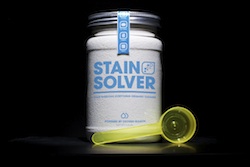May 16, 2011
Powdered Oxygen Bleach
If you're like me, you probably only thought there was one bleach as you grew up. I'm talking about chlorine bleach sold for decades in those white plastic one-gallon jugs at the grocery store. Who would have ever thought there is another bleach and it could be dry, not a liquid? Yes, oxygen bleach comes in a powder as well as a liquid.
Talk to a physical chemist and they think of bleaches in an entirely different way than you and I. A bleach to them is an oxidizer or and oxidizing agent.
Without getting all technical, suffice it to say that oxygen bleach is an oxidizer because it sacrifices oxygen ions to the many things it comes into contact with as it cleans. If you took chemistry in high school, you may have done an experiment with oxidizers. It's a pretty basic chemistry principle.
I remember Mr. Fuchs who taught chemistry my junior year at my high school, Roger Bacon. He had us doing experiments each week. He frequently copped an attitude with me and many others in the class. It's a dangerous thing to challenge the testosterone at an all-boys (it was when I attended back in the late 1960's, but now is coed) high school. You could get your house toilet papered one Friday night. I was never caught, but he knew I was the ringleader. But I digress.
The powdered oxygen bleaches that you can find online and in many stores has the oxygen locked up inside the tiny spheres of powder. Once the dry powder is mixed with water, it starts a chemical reaction that releases the trapped oxygen ions. When you mix the powder with water, you typically only create oxygen for about six hours. After that the chemical reaction ends and there is nothing but water and dissolved soda ash in the bucket.
But just after mixing the powder with water, these tiny ions are like little cruise missiles and the streak around in the liquid solution looking for organic stain molecules. So when you apply the mixture of oxygen bleach to a fabric, carpet, wood surface, roof, or anything that's dirty, the oxygen ions split the stain or dirt molecules into pieces rendering the stain powerless and invisible.
Most of the oxygen bleach powders are pretty stable and have a decent shelf life. You need to keep them dry and cool or cold to maintain their power. This means if you live in a humid climate and open the canister or container to get some of the powder, you let humid air into the can.
This humid air can start a low-grade reaction which can cause caking of the powder. It also releases some of the oxygen in the container making the powder less effective when you do go to use more.
To avoid this, see about storing the container in a refrigerator or even a freezer. The colder that air is, the less humidity it contains. So freezing the powder will allow it to maintain all of its original power.
Heat can also degrade an oxygen bleach. Avoid storing the product in a boiler room, a hot garage or a blistering hot attic. If the raw materials are stored for long periods of time in a hot warehouse, they can be less effective when put into the bottles for sale.

If you want an oxygen bleach that has the most power, you need to purchase one that has the most active ingredient in it. The Stain Solver product that I've sold for years is one of these.
We put in the maximum amount of active oxygen bleach as allowed by Federal DOT laws. The best part is that all the ingredients used to make Stain Solver are Made in the USA and the packaging and manufacturing is also based here in the USA. We need more products made here in the USA if you want my opinion!